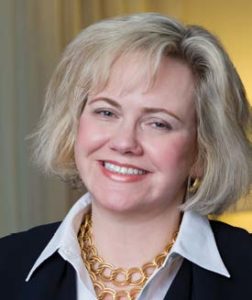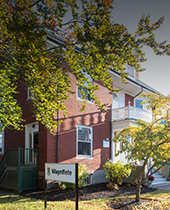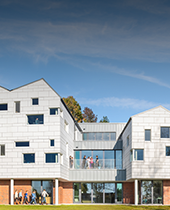As a difficult year came to a close in June, US Advisors asked their advisees what they were grateful for. They offered these responses:
I am grateful for the dedicated support from my peers and teachers, the welcoming charm and atmosphere Waynflete provides, and the abundance of opportunities to learn.
I am grateful for all those who have changed me, and all those who I have changed or by whom I have been changed, but not those who have never changed yet have never tried. Change and growth is vital, and this remarkable safe space must grow and change together to move into an even greater community of acceptance.
I am thankful for the quiet spaces in the school, for the teachers willing to offer a classroom and a chance to talk.
I am grateful for the cafe.
I feel so much gratitude for my friends who I’ve grown to consider family.
I’m grateful for the opportunities and experiences my time at Waynflete has given me, and the preparation for my future.
I came to Waynflete from a string of public schools, so coming in, I was astounded by the acceptance and sense of community I found here. I am truly grateful to the family I have found here.
I’m grateful for the support from my teachers and peers this year.
I’m glad to have good, caring teachers and staff.
I feel gratitude for being able to attend this school.
I feel gratitude for the supporting nature of the Waynflete community.
I am grateful for friends, family, and food.
I feel grateful for all the love that the teachers have given over this roller coaster of a year.
I am grateful for everything Waynflete has given me these past four years: the relationships, I’ve made with my friends and teachers, the experiences of sorrow and joy, a sense of confidence and comfort. I’m thankful for the memories that I’ve accumulated and will cherish forever.
I’m grateful for being trusted with independence at school.
I’m thankful for my country and all the freedoms within it.
I’m grateful for my friends and the people around me.
I’m thankful for all my friends and everyone I’ve met.
I’m grateful for the support I got from people who care about me.
I am grateful for my parents being my best friends.
I am grateful that I was able to have a relaxing, successful, and productive school year, even after I got into college early decision.
I’m grateful for the support from my friends, family, and especially my wonderful advisor.
I am grateful for Emily Graham and those special moments of spontaneous laughter.
I feel grateful for this community’s ability to understand and be sympathetic toward people who are struggling and support them through whatever it is they are facing.
I am grateful for: my friends, Breda, tea, and theater.
I am grateful for the small community and Breda’s coffee, tea, and baked goods.
I am grateful for the opportunity I have been given by going to this school and the incredibly supportive, open community. I would like to thank everyone for everything and I’m sure others would like to do the same.
I’m grateful for Breda and Cathie.
I appreciate the honesty that people show at Waynflete if they are not okay.
I am thankful for the support and kindness of my teachers, friends and peers at Waynflete; not one person has shown any misunderstanding of my feelings.
I’m grateful for all of my teachers and advisor who are always willing to talk and check in at any given time.
I’m grateful for the unique opportunities I have to learn as much as I can, such as the electives, the language trips, and the Oberlin-trained professional chamber musician who coaches the chamber music program.
I’m grateful that my advisors gave me permission to draw all over the homeroom windows. It was one of the best artistic outlets I’ve had in awhile.
I feel gratitude for all the nice students I teach (but not the bad ones).
I’m grateful that my teachers take the time to understand me as a person.
I’m grateful for all the support my advisor and teachers give me when I need academic or emotional help.
Kind teachers that are (for the most part) always available to reach out to.
The adaptability of the faculty and course structure during our difficult year.
I am grateful for my horse.
All (especially my friends) who have helped me so much through this difficult year. Thank you to you all.
I’m grateful for close, trustable friends and teachers who genuinely enjoy themselves.
I’m thankful for my teachers and my friends.
I am thankful for my friend, Blake Bondellio, for making me feel welcome at the beginning of the year and now, despite everything we’ve been through.
I’m grateful for the boundless love and care that is provided by my teachers and peers.
I’m thankful for the new perspectives Waynflete has given me and also for the support system it has been.
I am grateful for the many people in my life who care about me.
I am thankful I have my teachers, family, and friends who care for me and support me.
My mother.
I’m grateful for all the endless love and support I’ve received this year.
I am grateful for the cohesiveness of my grade—I will miss the comforts of their familiar faces, but I am so excited to see where we all end up!
I am grateful for Yai Deng.
I am grateful for the friends and family I am surrounded by and the community I come from that has raised me for pretty much my whole life.
I’m grateful for being given the opportunity to attend Waynflete for so long. I used to take it for granted because I didn’t know any better, but as I’ve grown up, I couldn’t be more appreciative of everyone who made it possible for me to be here.
I’m grateful for the food that’s available to me every day.
I’m grateful for everything Waynflete has taught me to be the best person I can be.
I’m grateful for the amazing, supportive, and open environment that I find myself in every day.
Friends.
I am grateful to have wonderful, knowledgeable teachers.
I’m grateful that I can go find help at anytime.
My teachers.
I’m grateful for Lowell when he crosses his arms and stands up tall.
The teachers and students because they care for you and are so kind it’s hard not to like any of them. Of course the cafe and the wonderful, nice, and kind ladies that always greet me with a smile whenever I go down there.
My friends…
I am grateful for the people in this school that give light, in so many forms, to this world.
I feel gratitude for the gracious manner in which the hardships of the year were handled.
My friends and Frannie.
I feel gratitude toward the graduating class of 2016, especially those who I have become very close with over the past 4 years (Rowan, Alanzo).
My gratitude for Waynflete is focused on my peers and teachers. I would not have been where I am today without the support, love, and kindness my teachers have provided me with this year.
Our community supporting each other.
I’m grateful for the flexibility of the majority of the teachers at Waynflete.
Loving community. Friendly environment.
I feel gratitude towards everyone in the community because of how happy and positive everyone is, even with what has happened this year.
I am very grateful for all my sports teams.
At Waynflete, I can never express how gracious I am for the kind and caring environment that never fails to support me, even in the worst times.
Having a mostly stress free year.
I hope this summer I meet new people and have a lot of fun with my friends. I also want to get a tan. I hope this school year I’m able to get good grades and get into the colleges I love.
Right now, I am grateful for my friends and the changing weather.
I am grateful for John Hoy’s beaming smiles and enthusiastic “hellos” in the hallways.
I am glad the school is respectful.
I am endlessly grateful for my teachers consistent support, and the profound intellectual curiosity they have instilled in me.
I am grateful for the comfort and freedom of the Waynflete campus.
I am grateful for my supportive teachers and friends.
I am grateful for my advisor supporting me through everything that occurred this year.
I’m thankful for the faculty and staff and how they have catered to the needs of the students.
I’m grateful for the teachers who support us.
I’m grateful for John Hoy.
The one and only….TC.
I’m grateful for all the experiences I’ve had here and all the people I’ve met.
I feel grateful for my advisors.
Freedom.
I feel gratitude that I got a 1 on my Latin final. Also I feel grateful for all my teachers that put their heart and soul in the teaching and for putting up with me this year.
Gratitude for my amazing teachers.
I am grateful for the power of love.
I am more than thankful for Lydia teaching me how important self-care is.
I feel gratitude when my friends listen to my creative ideas.
I feel gratitude when I successfully put a smile on their faces.
I’m grateful for the support from teachers to succeed even with a particularly challenging year.
I’m grateful for my amazing homeroom buddy, Emma. And being part of such a supportive community.
What I like about Waynflete is that the classrooms and hallways aren’t like a stereotypical school with the metal tile floors; we have carpets here. So I like that. This makes it feel more homelike and welcoming, instead of a very boring school feel. What would that be like is, “this is a school and it’s terrible, and it’s boring and it’s very meh here.” Waynflete isn’t meh. It’s a great environment.
I’m grateful for my teachers and their help and support.
My amazing homeroom buddy Ingrid. Pizza socks!
I’m grateful for my pet crab.
I am grateful for the small moments of love and caring that we shared together.
I am grateful for every person. They all make me smile to know they are a part of the community. I am grateful for the perspective each person brings to my life.
I am so grateful for my wonderful advisor and teachers who constantly support and encourage me.
I’m grateful for all the advisors.
I’m grateful for how comforting and helpful the staff were this year.
I am thankful for all the opportunities Waynflete has given me, and I’m thankful for all the amazing teachers and students here. It has been great! Thank you Waynflete!
I’m grateful for the experience I’ve had at Waynflete.
I am grateful for large rodents!
The support from Mimi and that this year taught me so much about myself and mental health.
I am grateful for this wonderful community that has supported each other through hell and back.
I am grateful for teachers who are understanding.
I feel gratitude towards my peers and all the support that my teachers have given me throughout the year. I also feel gratitude for the challenges that I have been given this year by my teachers and coaches.
I feel grateful for having such a good community that I always feel safe and supported.
I have gratitude for Marady Parr.
I have gratitude for my friends.
I am grateful for all the support given when it was needed.
I am grateful for the kindness in each and every person at this school.
I feel gratitude for Debba.
I am grateful to be part of such an open minded, safe community.
I’m grateful for the entire community feeling that Waynflete has and being able to talk to anyone when you feel the need to.
I love this school and the people here, but I have gratitude for the fact that this school isn’t in North Korea.
The teachers!!!
I feel gratitude for my friends and peers; without their support I couldn’t have made it through this year.
Not being paralyzed. Good food (at home).
I’m grateful for a supportive community with opportunity exams. I’m grateful for school being over.
I feel gratitude for the classes usually not being boring and pretty fun.
I am grateful for my good health.
The humor of my friends and teachers.
I am appreciative for the amount of sincerity the staff has with their thoughts, feelings, and kindness towards us.
I’m grateful for all the support I get from the teachers here at Waynflete.
I am grateful for all the teachers at Waynflete and the unending love and understanding.
I’m grateful for caring teachers and friends.
I feel grateful for the support I feel from the people at this school.
I’m grateful for living in the quaint state of Maine that is full of beauty and wonder as far as the eye can see (once you get out of Portland).
I feel grateful for all of the people who care about me and what happens to me.
I am thankful for the students who go out of their way to be welcoming and kind.
Thankful for the awesome teachers at Waynflete!
I am grateful for the ability to bond well with the teachers at Waynflete.
I am thankful for a small group of friends who support me.
I am thankful for Doc!!
Stephanie Dolan always being willing to talk.
I am thankful for the lunch ladies in the cafe, brightening my every day.
The guest teachers.
I am excited that I went to such a great school like Waynflete.
I feel gratitude for how much my teachers are passionate about what they teach.
The supportive Waynflete community.
I’m grateful for a smooth transition to Waynflete and for all the people that made it possible.
The sense of humor teachers have.
I am grateful for the supportive, kind, thoughtful, caring community I am a part of. I am grateful for the faculty, students, and people supporting me, especially through this tough year.
I’m grateful for the freedom to express myself and to find my niche in an environment of respect, love, and appreciation.
I am grateful for the amazing teachers at this school who helped one and all my peers through the most tragic time in my life.
I am grateful for the student faculty relationships we have here at Waynflete.
I am grateful for the strong friendships that I have gained throughout the year.
I’m grateful for senior project time.
The teachers at Waynflete.
Carson Ford.
I’m grateful that I met my best friend Gaia.
I am grateful for a kind and supportive school community, even in the hardest of times.
I’m grateful for the open minded people willing to have difficult discussions.
I am grateful for all the support and great friends I have at Waynflete and the endless encouragement.
I am grateful for my friends.
I am grateful for all my lovely peers who provide constant support and friendship.
I feel grateful for the close relationships I’ve had at Waynflete.
I’m grateful for nice teachers.
My friends.
Community.
I’m grateful for being in such a caring community.
I am grateful for an amazing homeroom teacher.
I’m grateful for all the support I have from teachers and students.
Something I am grateful for at Waynflete is the teachers and their loving attitudes!
I am grateful for perspective, and those who helped me gain it.
I’m grateful for the supportive community that has been built up so strongly this year.
I’m grateful that I have a clear list of what colleges I am applying to. I’m grateful for understanding teachers.
God, and my Guwap.
I’m grateful for my dog.
I am grateful for being me.
I’m grateful for the time spent at Waynflete, and the education I was given.
I am grateful for my cousins.
I am grateful for having supportive parents.
My mom.
I am grateful for the amazing support I get.
I am grateful for the people that I love. My happiness wouldn’t feel this confident if it weren’t for the people in my surroundings.
 Wordock continued to work in radio while pursuing his undergraduate degree at Vassar College. He joined Bloomberg Radio in New York City while at graduate school at the Columbia School of Journalism and went on to cover politics and business as a radio reporter. Wordock then ran MarketWatch.com’s radio network for six years, appearing on CBS stations in New York, Chicago, and Boston, before joining the Wall Street Journal in 2013 to head up its radio and podcasting group. “After you reach a certain experience level, you want to be able to influence what your industry is doing,” he says.
Wordock continued to work in radio while pursuing his undergraduate degree at Vassar College. He joined Bloomberg Radio in New York City while at graduate school at the Columbia School of Journalism and went on to cover politics and business as a radio reporter. Wordock then ran MarketWatch.com’s radio network for six years, appearing on CBS stations in New York, Chicago, and Boston, before joining the Wall Street Journal in 2013 to head up its radio and podcasting group. “After you reach a certain experience level, you want to be able to influence what your industry is doing,” he says. Binder is president and CEO of the Leapfrog Group, a Washington-based nonprofit organization. Leapfrog launched operations in 2000 after executives from some of the country’s largest corporations gathered to address a simple question: Why were their products and services held up to market scrutiny when the hospitals that provided care to their employees were not?
Binder is president and CEO of the Leapfrog Group, a Washington-based nonprofit organization. Leapfrog launched operations in 2000 after executives from some of the country’s largest corporations gathered to address a simple question: Why were their products and services held up to market scrutiny when the hospitals that provided care to their employees were not?





